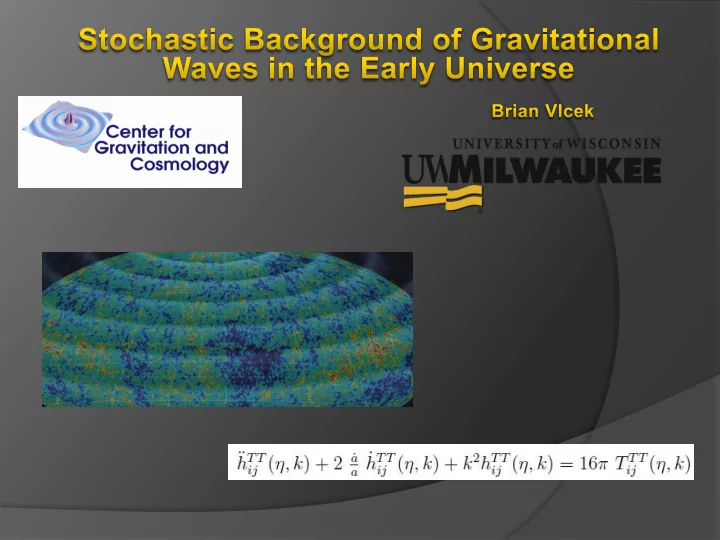

• CMB limits our (EM) view on the early universe • Using gravitational waves we can peer through the fog of the CMB to probe the physics of the big bang! Image from: http://abyss.uoregon.edu/~js/images/cmb_scatter.jpg
• Work at first order metric perturbations to FRW metric • Friedman Equations describe how our scale factor changes without effect from metric perturbations
• If the scale factor is known the solution to the metric perturbation is known in terms of spherical Bessel functions (Price & Siemens 2008)
• Use of LATTICEASY (Gary Felder and Igor Tkachev) to evolve the sources self-consistently in FRW space-time on a 3-D Lattice • We extract the relevant information for gravitational wave computations namely the scale factor and the stress-energy tensor
• Our code currently is generating GW in the early universe, via Preheating • The interaction term extracts energy from the inflation field , physically the inflation is decaying into chi particles • Anisotropic exponential increase in particle number (Kofman, Linde & Starobinsky, 1997) Parametric amplification of quantum mechanical perturbations = Source of Gravitational Waves
• Several methods of solving the metric perturbation equation including evolving the first order metric perturbation solutions via RK schemes (Easther, Giblin 2008), approximate Green’s functions (Dufaux, Bergman, Felder, Kofman, Uzan 2007) and exact Green’s functions ( Price & Siemens 2008) • The metric perturbations Gravitational wave power spectrum (Price & Siemens 2008)
• Comparison of exact Greens Function method to other methods show all to be in good agreement PS 2008 DBFKU 2007 EGL 2008 GBFS 2008 • All Green’s functions -based work replaces solid angle integration by an average over 6 independent directions in k-space
• To improve on the method of Price & Siemens we calculate all values of the metric perturbation on all of the lattice • Use metric perturbation to interpolate values and calculate solid angle integral without averages Old method New method
• Approximate scale factor in the metric perturbation calculation, via linear-piece wise function
• Calculating this with a computer requires an approximation… • This sequence simplifies to • Which is an approximation to
• When this expression is taken as the approximate solution, it does not fully satisfy the original differential equation • However if one can show this additional term goes to near 0 at a selected time then it will be a good approximation to the full solution -The additional term goes to 0 for late times in cases of
• Can I guarantee that this term will always be small at late times? • If correct we can take ANY MODEL of the initial fields in the universe produce a gravitation wave spectrum via exact greens function method + full solid angle integration • Ready to test interesting models such as phase transitions (radiation matter dominated) which the scale factor will not have a simple form
Recommend
More recommend